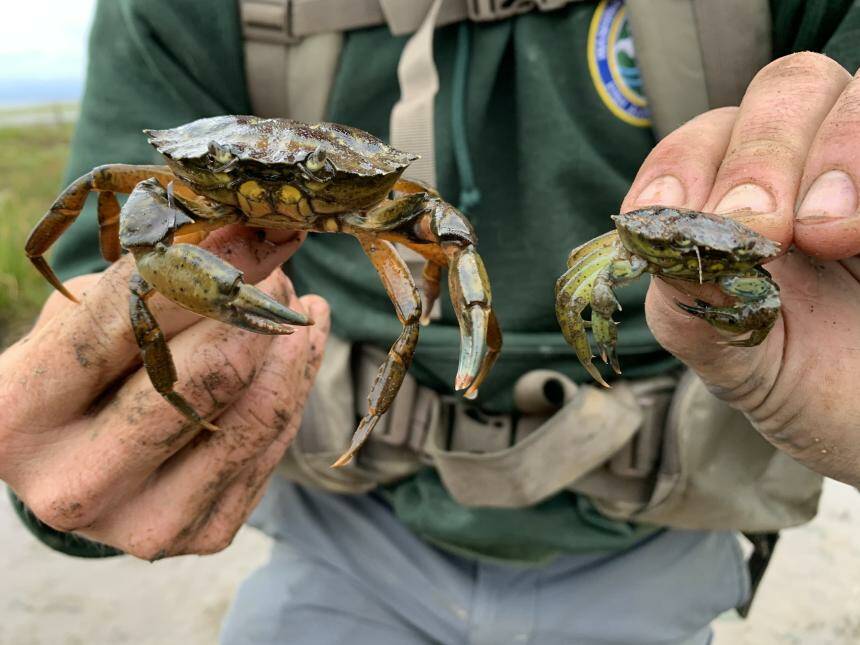Gov. Jay Inslee, in partnership with the Washington Invasive Species Council, proclaimed the week of Feb. 26 through March 3 as Washington Invasive Species Awareness Week in solidarity with National Invasive Species Awareness Week.
The week will be marked with a series of webinars and events aimed at sharing information on priority invasive species, risks to the economy and environment and ways to become part of the solution.
On Whidbey Island, the state and county officials are mainly focused on green crab, poison hemlock, cord grass and garlic mustard.
Whether on land or in water, some human-introduced organisms such as fish, bugs, plants, other wildlife and even diseases can damage agriculture, recreation, forests and other resources. Invasive species are a global problem that has cost the United States more than $1.2 trillion in the past 50 years. A 2017 state study estimated that some species not yet in Washington, such as invasive freshwater mussels, would cost the state more than $100 million annually in damage and loss if they were not prevented.
“There is a lot at stake in Washington,” said Stephanie Helms, executive coordinator of the Washington Invasive Species Council, in a press release. “Invasive species threaten the survival of endangered species such as salmon and orca. Some pose a risk to agriculture, trade and food supplies, and some can change natural processes increasing wildfires and flooding and reducing water availability.”
On Whidbey Island, the Washington Department of Fish and Wildlife monitors European green crabs, said public information officer Chase Gunnel. Don’t be confused by the “green” moniker. The shell, typically about four inches, can vary from reddish to dark green, and the crab is more easily distinguished by the five points on each side of its shell. It has round lobes between its eyes, and its final pair of legs are partially flat.
They live in shallow, near-shore intertidal areas, eating native shellfish like clams and devastating estuaries and eelgrass beds. The game department, partnering with local tribes and shellfish growers, have recorded them in small numbers on the west side of Whidbey and in much greater numbers in the Lummi Sea Pond and on the San Juan Islands.
Containment is more efficient than reaction, Gunnel said, so while they haven’t seen great offenders like the northern pike, zebra and quagga mussels and New Zealand mud snails in large numbers on Whidbey Island, they watch out for them. Once the can is opened it’s hard to close.
“We don’t expect to eradicate European green crabs in Washington,” Gunnel said. “There’s too many of them down in our neighboring states like California and Oregon, but we think we can control the numbers.”
European green crabs are native to Western Europe from the Baltic Sea to North Africa, Gunnel said, and were brought to the East Coast U.S. in the 19th century on ships. The first place they were found on the West Coast was San Francisco Bay. Since the 1980s, these crabs have moved north, likely because of El Nino. They first appeared in the Salish Sea in the 1990s.
In the weed world, poison hemlock is the current troublemaker, said Island County Noxious Weeds Program Coordinator Seth Luginbill. Poison hemlock, a member of the carrot family, can be found in open sunny areas like fields, lots and roadsides. Distribution has plumed in the last decade.
Poison hemlock, which pops up in the springtime, attacks the respiratory system and is harmful to humans and livestock, Luginbill said.
Garlic mustard, which exists in small numbers on Whidbey, is another huge offender statewide. Garlic mustard spreads through understories of forests, destroying biodiversity and, as a result, vital habitats for animals.
The good news is, unlike invasive fauna, weeds can be eradicated, Luginbill said. Working with landowners, this is starting to be possible for garlic mustard.
As dangerous as garlic mustard, common cord grass impacts forage habitat for juvenile salmon populations and nursery beds for shellfish, which is detrimental to those animals along with commercial industries and recreationalists. With Washington State Department of Agriculture funding, Island County is on track to fully eliminate common cord grass in the next ten to 15 years, he said.
Most of the worst invasive weeds came originally from Asia or Europe, Luginbill said. Like fauna, they came to the East Coast first and spread west. Dense stretches of garlic mustard can be found in North Carolina, Michigan and up into Ontario.
The public plays an important role in monitoring these species, Helms said, in discovering them and preventing the spread. According to the press release, some things people can do to prevent the spread of invasive species is clean outdoor gear and clothing, look for noxious weeds when outside and dispose of pets and bait properly, not into waterways.
“If you’re transporting a boat or a kayak or paddle board across the state, maybe across state lines, you really need to clean, drain, dry,” Gunnel said. “You need to make sure there’s no aquatic hitchhikers.”
One of the biggest things people can do is stay informed and be ready to identify, Luginbill said. Washington Invasive Species Council has an app for identifying and reporting invasive species.
Washington is a wonderful place to call home for its clean water, abundant natural resources and ample opportunities to recreate on land and water, Helms said. Invasive species are a threat to all these things.
“It’s something we’re facing here in Washington State where we’ve invested billions of dollars on salmon recovery and habitat recovery,” Gunnel said. “Some of these basic species could really undermine those efforts, and it’s something that we need to get a handle on now. So, it’s not just another threat that our ecosystem or our salmon or our orcas are facing. We ask people to join us on that fight and help keep an eye out for invasive species.”



